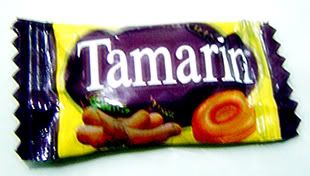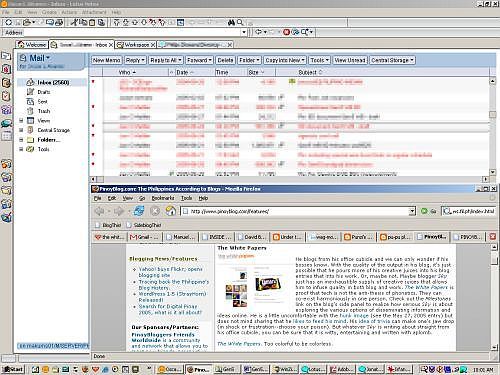Wednesday, June 29, 2005 by sky
And we're not talking about GMA's Monday night speech. We are the third largest nation of bookworms.
According to the NOP World Culture Score reported in the BBC, surveying 30,000 people in 30 countries from December 2004 to February 2005, Filipinos come in third in terms of average hours a week spent reading books, newspapers and magazines, while US, UK and Japan came in 23rd, 26th and 29th.
How did this happen, given that in a typical middle-class household, dusty encyclopedias rule the bookshelf like it is part of the furniture, I don't know. Next to encyclopedias, textbooks occupy the most available space. Baron's Booknotes on Les Miserables and Silas Marner. And probably, unfinished bestsellers like the Da Vinci Code and A Purpose-Driven Life gathering dust competing with the househelp's dog-eared Valentine Romances. In a corner a pile of Bulgar, Inquirer and Abante.
In India, which topped the survey, "A lot of [book reading] is aspirational, getting ahead in the rat race, getting admission into schools and colleges etc. It has less to do with reading, more to do with rote."
I think the situation is similar in the Philippines, where reading for reading's sake is not on the plate of Everyman. Seeing the pile of books bursting at the joints of my old bookshelf, a friend and classmate in my masters class quipped: "You've read all that?" The issue of reading for pleasure transcends class boundaries. Most who can afford to buy books and have the time to would play safe by procuring the latest bestseller, talk about it in their circles as part of social acceptance and wouldn't have the patience to scour for hours what other titles would have imparted them with.
The news did not bare details on what topics Filipinos generally read, and on what medium on hardcopy (I assume)--books, newspapers, or magazines, and the profiles of the population sample. I speculate, given the accessibility and affordability of newspapers--you can read anywhere there's a hawker, even grab a free tabloid inside an MRT station. In fairness this is good news because we still feed our minds with passion or poison.
There's digression on my part--we may be the third bookie nation on earth but what are we exactly reading?
*We're the second largest nation of TV watchers, clocking 21 hours per week in front of the idiot box. Now this is more convincing.
  | » | »
Tuesday, June 28, 2005 by sky
"He blogs from his office cubicle and we can only wonder if his bosses know. With the quality of the output in his blog, it's just possible that he pours more of his creative juices into his blog entries than into his work." How do I do it?
It's been posted for four days already. I'm Pinoyblog's Featured Pinoyblog of the Week since June 24. You can rate my blog here: http://www.pinoyblog.com/features/. "I am not anxious to protect my votes and have no plans of conversations with many people, including a Pinoyblog webmaster. My intent is not to influence the outcome of the Featured Pinoyblog of the Week ratings, and I hope it will not."

An aside: My blog's been rendering white spaces after the latest post--Firefox issues. Haven't seen this in IE or Maxthon. Apologies for the inconvenience.
  | » | »
Monday, June 27, 2005 by sky
Sinisipag sa trabaho pero di tumataas ang sweldo?

Tamarin.
Ang candy ng nagtatrabaho.
Tamarin.
Mahihingi sa inyong suking sekretarya.
Also available: Avon, Sara Lee and Pampanga's Best.
  | » | »
Wednesday, June 22, 2005 by sky
Ano nga ba ang "random" sa salitang Filipino? Di naman pwedeng samu't sari. Wala syang pattern, plano o purpose. Basta, kapag ganitong meron akong gustong i-blog pero hindi sya akma bilang isang full-blown na tema, ililista ko na lang. Sa mundo ng engineering, o at least sa pinagtatrabahuan ko (dati), ang tawag namin sa mga bagay na kailangang pagbigyan ng pansin pero di sya nauukol sa kasalukuyang kalagayan ay tinatala sa "bin list." Self-explanatory. No particular order. Pwede rin sa sideblog ko pero dito na lang.
1. My take on Sulfura's chemistry is cited here: the Darna blog.
2. Shout out to jdavies and his Tanaga project. I've known this indigenous literary form during grade school. One project I remember being given by my mom to her students is to produce visual art based on accents in some tanaga pieces.
3. Editing activity for Warm Bodies: Project 2 is in full swing!
4. I think I'm turning Japanese.
Books read: Alan Brown's "Audrey Hepburn's Neck" (again), Arthur Golden's "Memoirs of a Geisha" and Haruki Murakami's "The Elephant Vanishes and other stories."
MP3's downloaded: Chodenshi Bioman, Chichi wo Motomete, Astroboy Theme, Uran Theme, Prism of the Wind
Food: Saisaki--Walang matinong Hapon ang kumakain sa Saisaki.
UPDATE: Furusato @ Carmelray Industrial Park. You wouldn't know what lies behind those sugarcane fields (there's even a Dencio's near our site, I've heard).
5. Suman Latik photomosaic--noticed the pictures? They're a preview of something great to come your (and my) way.
6. Subscribe to the white papers! Enter your e-mail in the form field found on the lower left side of my blog, under the "concerns and considerations" header.
  | » | »
by sky
"It was there inside the bayong, wedged in between the bisugo and brisket all along. But the househelp contests that she hasn't seen one grain of suman latik the moment she washed and loaded the groceries to the freezer." Click anywhere on the list to satisfy your Suman Latik cravings: Jonas Clair Iris The Captain Dean Elias Sean Dominique Kel Banzai Cat Jac Ranulf
  | » | »
Tuesday, June 21, 2005 by sky
My first year in the real world entailed specializing in Electrostatic Discharge (ESD) management and one of the activities I enjoyed was giving training sessions to new employees. In the electronics industry, ESD has been seen as a threat to profitability and customer satisfaction because of the sheer number of products falling out on a typical manufacturing day just by a single spark straying from an operator's fingers. And if some of these units pass quality assurance and make their way to the market, we get irate phone calls from customers receiving these "walking wounded" electronic parts.
It's not an exciting field though, for the idealistic me at that time, since all I need to do was to check for compliance in the manufacturing floor for ESD countermeasures day in and out. No white papers were asked, which the writer in me sulkingly obliged and subtly resisted. And so in the next few years I moved into "hard" operations engineering and lately, research and development. I thought that the training material I made when I recently opened it got corrupted, was the end of my fleeting relationship with ESD. Dean's entry on this irritant however, and the existence of all-too-technical information on ESD wanted me to write this special Skythologies entry on static electricity and electrostatic discharge.
To office cube dwellers, static electricity means being "zapped" while reaching for the doorknob in a drab-gray carpeted room. Too aware perhaps, that they know it's not a stern reminder to get back to their seats, start working and keep coffee breaks and water dispenser conversations at a minimum. Partially, they are correct, but the term "static electricity" is a misnomer. In basic electricity, surfaces can have positive or negative charges (much like the positive and negative poles seen in batteries). These surface charges are what constitutes static electricity, officially defined by the ESDA as "an imbalance of electrons on the surface of a material". And they are an accident waiting to happen.
One fundamental law of nature, which is also applicable to humankind, is that it prefers the path of least resistance. Take gravity for example. It's easier to fall down than to go up. In electricity, it's natural for electrons to flow from a point of high resistance (like insulators--carpet fibers in our example) to a point of low resistance (like metal--the doorknob). To be exact, it's the path of least potential (loosely, electric potential is the pressure that can push electric charges to different locations) that electricity wants. The flow from high to low potential is called "current." A sudden flow of surface charge, meaning a large difference of potential values, meanwhile, causes discharge. Thus the term electrostatic discharge.
Perhaps the most famous, and deadliest example of ESD is lightning. The insulator in this case is air. The low resistance point is the earth, appropriately named "ground." The difference between air and ground in terms of potential runs into millions of volts. The resulting current that flows between air and ground heats the air, causing an explosive release of energy.
And you expected sparks would be flying on your first date? Here's a tip: set it during the dry season, comb your hair often, go traipsing on the carpet and reach for the doorknob together. How is this so?
Walking on the carpet during the dry season generates 35,000 volts of static electricity. In humid atmosphere, it's around 1,500 volts. Combing your hair (use plastic comb) adds a few thousand volts more. Humidity reduces potential levels because of the presence of water particles in the air which may neutralize the static charge that you've been trying hard to gather. Metals are the best conductors of electricity, and the static you have built up would flow abruptly.
Now if you ask where you can buy sparks, good news: it's free. Like blind dates, expect irritation or shock though.
Reference: ESD Association, Fundamentals of ESD
Next on Skythologies: Molecula, Muyak and the quantum promise
  | » | »
Friday, June 17, 2005 by sky
"Gloria to declare Martial Law on June 21."
--Excerpt from a text message. Walang originality.
  | » | »
Thursday, June 16, 2005 by sky
 It's been sixteen years since time stopped.
*W.H. Auden
  | » | »
Wednesday, June 15, 2005 by sky
My personal challenge for the suman latik webring is to get one image and make permutations of it, week after week. Unf, due to my forced hiatus in the previous workweek my contribution has been pushed out. Here's a wallpaper for the webring. I've used Fortunaschwein font, rendered in EyeCandy 2000 chrome filter to suggest how latik manifests its viscosity.
If you're interested in getting the 1024 x 768 wallpaper, please let me know and I'll send it to you. Click anywhere on the list to satisfy your Suman Latik cravings: Jonas Clair Iris The Captain Dean Elias Sean Dominique Kel Banzai Cat Jac Ranulf
  | » | »
Tuesday, June 14, 2005 by sky
For purely business reasons when I had to play doting yayo to a foreign counterpart, I was on forced hiatus for the past week. Millions are tuned in to the tapes that would end all tapes (and maybe, a political career too). I've been mulling too, silently like a geisha while in the middle of my ward's epistles, on the prospects of another people power. Haven't we, at one time been perceived by the rest of the world as the hardest place to be a president? Changing terms like we're changing cellphone housings when we're out with the old? Or fed up, to be exact, when it's been forced upon us? We are not zombies anyway.
Ok ba sa intro?
We've seen them in Michael Jackson's "Thriller" MTV, consuming tons of corn flakes as makeup to mimic rotting flesh. It's the zombie stereotype--arms forward while marching and circling their victim, who would later on become another zombie. "Thriller" wasn't the first. In 1968, "Night of the Living Dead" and its 1978 sequel "Dawn of the Dead", paved the way for the typical household zombie, with a bullet to the head the only way to kill it. Then there was the "Return of the Living Dead" trilogy during the 80's which portrayed zombies out to consume human brains, picky as they were which set them apart from the cannibalistic undead of old.
It's been said that zombies exist in real life, and we're not counting the cube-dwelling engineers just yet. There had been reports in Haiti of persons who have been brought back from the dead and were employed (yet unpaid) as plantation workers back in the 19th century. These zombies can eat, hear and speak, but have no memory of their previous life. To make one a zombie according to Wade Davis, an ethnobiologist who researched on the Haitian zombie, first, make them "dead" then make them "mad". Now here's the recipe.
Ingredients: toad skin, puffer fish, datura
Equipment: funeral tableau, witch doctor paraphernalia
Make them dead...
Mix the skin of a common toad (Bufo bufo bufo) and puffer fish (known in Japan as fugo) and put it in your victim's food or rub it in the soft part inside the arm just above the elbow.
Wait for victim to breath slowly. Ensure faint heartbeat.
Recite some chant for effect and fanfare.
Bury asap and dig after eight hours (victim may die of asphyxiation). ...then make them mad. Force-feed your zombie-in-waiting with a paste made from datura (Jimson's weed).
Sell to sugar plantations as slave labor.
Feed with datura when zombie seems to regain senses. The skin of the common toad is deadly, containing biogenic amines, bufogenine and bufotoxins. These are pain-killing substances far stronger than cocaine. Pufferfish on the other hand contains tetrodotoxin which decreases the body temperature and blood pressure, putting the victim into a deep coma. Datura contains atropine, hyoscyamine and scopolamine, which can act as powerful hallucinogens. This paste has to be skillfully administered so that the witch doctor won't kill the victim. I'm not sure if these ingredients are locally-available, but with the Independence weekend and the events which unfold everyday courtesy of PCIJ and MLQ3 true-grit feeds, would you rather not regain your senses, and go back to a specific February week in 1986, dancing in the streets after the dictator left, never knowing that it would be worse in the next nineteen years? References: Great Moments in Science
Death Central
Wikipedia on Zombies Fine print: I'm not espousing zombiism or the occult. This post is intended to let ordinary folks understand what common media has been feeding us over the years. Dr. Zombie's zombies are the product of artificial intelligence, as I speculate. Those in the movies have been irradiated with unknown energies from outer space. Like religion, there is science behind everything.
Kids, don't try this at home, even if you have stock of the ingredients mentioned.
  | » | »
Tuesday, June 07, 2005 by sky
Why was the original Yellow Four killed in Bioman's Episode 10?
The most authoritative page on Bioman has documented one chismis (yes, even sentais get intrigas): Obviously, because the actress [playing Yellow 4] Yuki Yajima had to leave...This is one apocryphal story that I've heard somewhere: Yuki Yajima is a member of the Japan Action Club or JAC, a group of stuntmen. Her contract was with THEM, not directly with Toei. I was told that at the time, JAC was in a financial nadir, and [she] quit JAC. The problem is, by quitting JAC, she couldn't continue with Bioman anymore. It hasn't been confirmed though. Bottomline, Yuki Yajima had to leave abruptly that filming the 10th episode was impossible. So if some of you may have noticed with your juvenile eyes at that time (1986 probably), Yellow Four appeared in her costume in the episode where she died, but Yuki Yajima only appeared in flashback sequences. This bought enough time to search for a new Yellow Four in the person of Sumiko Tanaka. Case solved. It took me almost 20 years to find out. *Is there the sign in your heart? (first line of the opening song, Cho-Denshi Bioman) Image courtesy of the aforementioned site.
  | » | »
Friday, June 03, 2005 by sky
They're back. From men.style.com
  | » | »
Thursday, June 02, 2005 by sky
My suspicions were right. In recent developments, Dr. Zombie's, er, zombies were exterminated by his undead wife by "clicking" yes on the query button asking if the zombie program would be terminated. AI--not American Idol, but artificial intelligence at work. Artificial neural networks (ANN), to be exact.
In my reimaginations of Dr. Zombie (and his minions), I picture him as an extraodinarily intelligent combination of man and machine. His zombies are actually embedded with computer programs that simulate a human being's movements, and Bluetooth-enabled too to enable him to command them within a specific radius. Plus decaying flesh of course, the works. His Nutribun top contains a microprocessor that gathers data as he receives it--Darna's punches, body moves and plasma emissions--learns them, formulates counterattacks, implements them, gets data and builds up on previous learnings. He is virtually indestructible, and only he can end the program and destroy himself.
Dr. Zombie's embedded program to counter Darna's punch by increasing his counterattack a hundredfold would look as such, with a subprogram invoked elsewhere to regenerate any part that she has damaged. This program will repeat itself if Darna is still alive and will end when our superheroine is dead:
DO LOOP (Darna = Alive)
IF bodypart = damaged
GOTO regenerate_damaged_Zombie_part
END IF
Measure Darna's punch P
P (Zombie) = P (Darna) * 100
Attack
END LOOP This is the essence of artificial neural networks--get data, learn, implement--ideally an endless cycle for improvement, or an end to itself when Dr. Zombie's opponent is beaten to pulp. This is also similar to how our brain works. A toddler learns a specific word such as "star" and blurts it out barely recognizable. Years pass and we hear the toddler, now a grown-up, recite "star" in different accents, languages and meanings. I won't go into the intricacies of artificial neural networks here, but unlike ordinary computer programs which run from the top down, ANN's are recursive until the result is perfected. Artificial neurons process these information, bits of programs connected together by a string of commands for complex applications. The human nervous system has about 100 billion neurons (brain cells) which interconnect and carry information that has been passed through nature and nurture. An ant's nervous system has 20,000. Despite advances in computer science, artificial neural networks have most likely 1,000 artificial neurons maximum. Still a long way to go, but we already see examples all the time. Bar code scanners in groceries and digital office bundy clocks are the most familiar example I can think of. These scanners "learn" the price of the item or identity of the person through a central database where the information is stored. When an item is scanned or a person flicks his ID into the reader, the appropriate action is taken--charge the price, or let the person in. There are situations when the bar codes are distorted or faded, but the information can still be read--ANN working double-time. The security industry takes advantage of ANN by teaching the computer to learn, for example, a person's jawline, iris structure, and thumbprint--collectively known as biometrics. I had some of my biometrics stored in my previous company ID. Changes in the person's biometrics won't impact the database, say, surgery, because the computer can forecast these changes from the person's original data, except of course in the most extreme of circumstances. Voice typing, one of Windows XP's utilities, is also a fine example. You teach the computer to recognize your voice using pre-selected words in a very quiet setting, which it stores in the database, and types words you speak in, say, MS Word through a microphone. Nifty, but far from perfect still. So, is the Call Center Agent you spoke to really a human being? Customer service is one of the areas where ANN is tapped, storing in company databases previous customer profiles, requests and feedback. Already, ANN has been successful in process engineering (I take them for breakfast), quality control, financial forecasting and intelligent searching (banner ads, suggested search words and Google AdSense). Except for the voice-recording "press 1 for directory assistance", and not in a few years from now, yes, you're still speaking to a warm-bodied human agent. If you do get nervous, press 0 to talk to a human customer service representative. Next on Skythologies: How to Make Your Own Zombie, and next next, some stuff about Electrostatic Discharge (ESD).
  | » | »
Wednesday, June 01, 2005 by sky
We celebrated my mother-in-law's birthday in Rose and Grace, a restaurant situated in front of Paseo de Santa Rosa, which serves fairly good bulalo. And of course, the inevitable happened.
I ate suman latik. But I didn't see my crush today.*
Avignon font, size 72 and 36.
Manual kerning (ang hirap ah).
Chrome Filter Plug-in from EyeCandy 2000.
Click anywhere on the list to satisfy your Suman Latik cravings: Jonas Clair Iris The Captain Dean Elias Sean Dominique Kel Banzai Cat Jac Ranulf*If you've been to the First Blogging Summit, you'll get this and smirk.
  | » | »
|

Punch me, I'll bleed.
|










